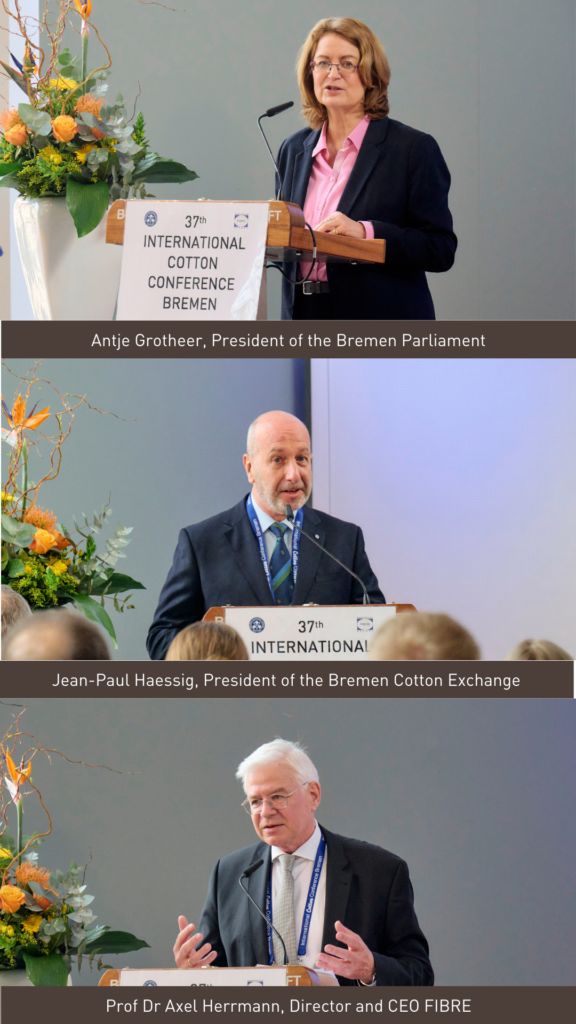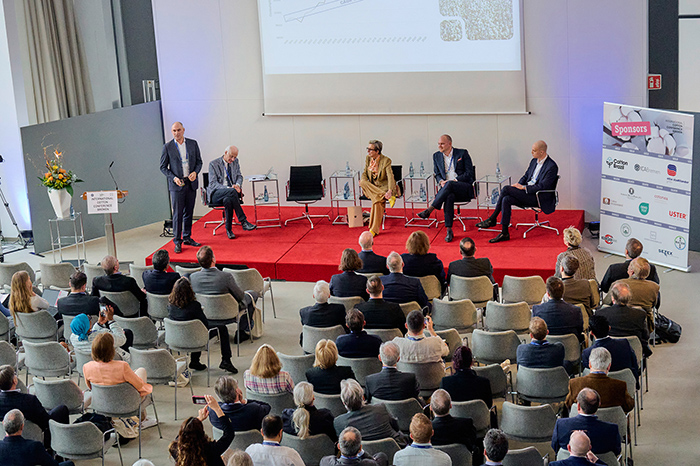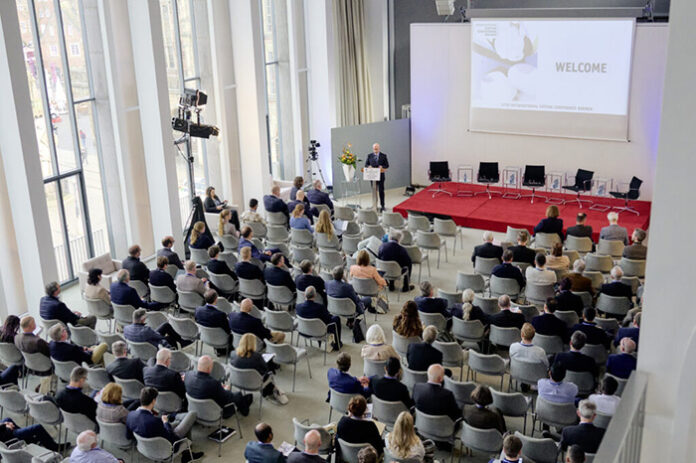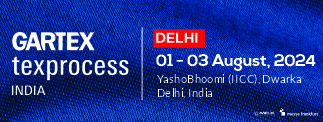Around 400 participants from almost 40 countries attended the 37th International Cotton Conference Bremen from March 20 to 22. On site and online, guests were able to attend eleven sessions with almost 70 speakers and find out about the latest research findings and innovative practical applications in the cotton industry. This year, the Bremen Parliament served as venue for the International Cotton Conference Bremen for the first time.
 In the bright ballroom of the building with a view of the historic ensemble of Bremen‘s market square, the President of the Bremen Parliament, Antje Grotheer, welcomed the international participants at the start of the conference.
In the bright ballroom of the building with a view of the historic ensemble of Bremen‘s market square, the President of the Bremen Parliament, Antje Grotheer, welcomed the international participants at the start of the conference.
“For a few days, Bremen was once again the centre of the cotton world. Presentations at a high professional level, exciting discussions and in-depth insights into industry-wide progress once again made it clear that the Bremen conference is an essential module for exchange within the cotton community. This was demonstrated by the lively debates surrounding the current legislative proposals with regard to sustainability and transparency with consequences for the entire industry,“ said Jean-Paul Haessig, President of the Bremen Cotton Exchange.
“The joint organization of the International Cotton Conference by the Bremen Fibre Institute and the Bremen Cotton Exchange is an excellent example of how science and practice can complement and benefit from each other. The diverse and top-class conference programme as well as the many expert meetings on the fringes of the conference speak a clear language again this year,” added Prof Dr Axel Herrmann for the Faserinstitut Bremen (FIBRE).
Highlights of the conference: the keynotes

The keynote sessions that opened the day were among the highlights. Colin Iles, Executive Manager Cotton & Sugar at Viterra, got the participants in the right mood with his enlightening and entertaining overview of current developments on the commodity markets and their impact on cotton.
Analyst Veronica Bates Kassatly provided plenty of material for discussion by focusing on the upcoming legislative regulations and their serious consequences for the entire industry. This was supplemented by practical recommendations from Commerzbank representatives Manuel Höchemer and Lennert van Mens. They showed how companies in the European Union can navigate new regulations on sustainability reporting.
The keynotes on Thursday as well offered a select mix of inspiring insights and exciting facts from the world of cotton and beyond. Nicolas Rubio reported on his experience in European politics in his role as an Agricultural Counsellor at the United States Embassy in Berlin. Hubertus Lohner, Airbus Operations in Bremen and Head of the ECOMAT Technology Centre, presented ways in which the use of natural fibres can contribute to the decarbonization of the mobility sector – especially in aircraft construction.
Panel discussion with focus on Vietnam
Under the headline ‚Region in Focus‘, the session focusing on the Vietnamese cotton and textile industry highlighted the dynamic industry in the Asian country. Thuy Vi Nguyen from the Vietnamese Cotton and Spinning Association VCOSA, Yen Tracy Mai, President and CEO Long Van Yarn Ltd and Graham Soley, USDA analyst, paved the way for a lively discussion among the representatives and experts of the Vietnamese textile industry.
Sustainability as a cross-cutting issue
The topic of sustainability is now interwoven with the various areas in the supply chain, so that it no longer stands out as a single topic, but rather must be considered everywhere as a cross-cutting issue. As a result, practically all sessions on topics along the cotton supply chain included aspects of the now so broadly diversified area of sustainability.
The research work of Filipe Natalio, for example, with the aim of understanding the underlying mechanisms of natural organisms in order to produce biological materials such as cotton with special sustainable properties, deserves special mention. But there were also exciting presentations with intensive discussions on other sustainability-related keywords. These included, for example, the presentations ‚Environmental impact of cotton cultivation systems‘ by Jens Soth, Helvetas, and ‚Textiles on the way to a circular economy‘ by Stefan Schlichter, Augsburg University of Applied Sciences. The conference also addressed issues relating to traceability and transparency as well as the impact of climate change and fair incomes on the lives of cotton farmers.
Focus on recycling
The topic of recycling played a special role during this conference. This session which demonstrated exemplary cooperation between research and practice, focused on the quality of cotton fibres in the recycling process. During the discussion, it became clear what opportunities, but also challenges, exist in the recycling of this natural fibre.
The topic of recycling was also on the agenda of the Spinning & Textile Seminar in the run-up to the conference. The four organizers, the Bremen Cotton Exchange, the Bremen Fibre Institute (FIBRE), the International Textile Manufacturers‘ Federation (ITMF) and the German Industrial Association for Yarns and Textiles (IVGT), had once again invited participants on Tuesday. Under the title ‚Use and challenges of fibres in textile recycling systems‘, speakers from the textile industry shed light on the recycling value chain from the sorting of used clothing to the new product from a practical perspective.










